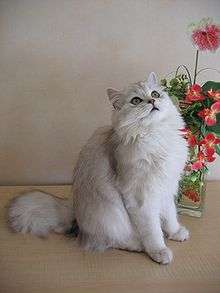British Longhair
| British Longhair | |
|---|---|
 | |
| Breed standards | |
| TICA | standard |
| FFE | standard |
| Domestic cat (Felis catus) | |
The British Longhair[1] is a medium-sized, semi-long-haired breed of domestic cat, originating in Great Britain.
History
The British Longhair is a longer-haired development from the longstanding British Shorthair breed. In the mid-20th century, British Shorthairs were interbred with imported long-haired varieties, like the Turkish Angora and what today is called the Traditional Persian, with an aim to producing more stout and round-faced stock, while retaining the short coat. As a result of this hybridization, British catteries have frequently produced (generally unwanted) semi-long-haired specimens among their litters. In more recent years, these have been intentionally bred (often outside the UK) to each other and sometimes to standard British Shorthairs, to establish a consistent, formalized British Longhair breed.[2]
Breed recognition
Neither of the two major cat fancy organizations in the UK, the Governing Council of the Cat Fancy or Felis Britannica (the UK branch of Fédération Internationale Féline) recognize the cat as a breed or as a coat variant of the British Shorthair. The naming of the breed, and whether it is treated as a distinct breed, is quite inconsistent between the few pedigree registry organisations that acknowledge it as of 2015. It is called the British Longhair,[3] British Longhair Variant,[4] British Semi-Longhair, and Longhair British. It is sometimes known as the Britannica in some European countries, and also the Lowlander in the United States.
Feline Federation Europe (FFE) calls them (in the same breed standard), the British Longhair Variant, the Highlander, and the Highland Straight.[4] However, the latter two of those names have already been used by other registries to refer to completely different cats. The Highlander (with a variant, the Highlander Shorthair) is actually a development from the American Curl, and not closely related to the British breeds; it is a very large cat, with close-set, often upward-curling ears.[5][6] The Highland Straight, a British breed, is actually the straight-eared variant of the Highland Fold; together, they are the longer-haired versions of the Scottish Straight and Scottish Fold, respectively.[7][8] (TICA uses different terminology: Scottish Fold, Scottish Fold Longhair, Scottish Straight and Scottish Straight Longhair, to avoid confusion with the Highlander.[9])
Appearance
Apart from its coat length, the British Longhair is identical to the British Shorthair.
The coat is lustrous and physique is stout in general. The head is broad, and round or even squarish, with bright circular eyes and short ears. The legs are somewhat short, but strong. The tail is plush and thick. The chest is deep, giving the overall impression of a compact, medium-sized cat. The belly hair may be curly.
British Longhairs can come in a wide variety of colours and patterns, just like the British Shorthairs. These colours include black, white, red, cream, blue, chocolate, lilac, cinnamon, or fawn. With all of these colours, the patterns can include self, tabby, tortoiseshell, bicolour, smoke, tipped, and (in some registries) colour-pointed.
Temperament
According to breeders, British Longhairs are quite calm and easy going. British Longhairs make good indoor cats, as they are less active than many breeds, and content with a sedentary, comfortable life.
Health
British Longhairs are more likely to suffer from kidney complaints than various other cats.
British Longhairs can be prone to obesity if neutered or kept as indoor-only cats.
Like most longer-haired cats, they require brushing or are prone to matting. Autumn and winter are the seasons when they have the highest risk of tangles because their coat thickens in preparation for winter.
References
- ↑ "British Longhair Breed Introduction". TICA.org. Harlingen, Texas: The International Cat Association (TICA). Archived from the original on 5 March 2013. Retrieved 5 March 2013.
- ↑ Preiss, E., "British Longhair: An Experimental or an Old, Long Ingnored Breed?", WCF-Online.de, WCF 2008 General Assembly, Essen, Germany: World Cat Federation, retrieved 10 July 2015 Eembedded Flash presentation. This tertiary source reuses information from other sources but does not name them.
- ↑ "Persian Breed Group" (PDF). TICA.org. The International Cat Association. May 1, 2004. Retrieved July 10, 2015.
- 1 2 "British Shorthair and Highlander". FFE-Europe.de. Feline Federation Europe. 25 September 2004. Retrieved 9 July 2015. Note: Due to poor coding at this site, this link goes directly to the standard's content. To see it loaded in the site's navigation frame, go to http://www.ffe.europe.de, and manually navigate to the breed's entry under the "Races Standard" menu item.
- ↑ http://www.tica.org/public/breeds/hg/intro.php
- ↑ http://www.catsofaustralia.com/highlander-cat-breed-description.htm
- ↑ http://www.wcf-online.de/WCF-EN/standard/semi-longhair/highland.html
- ↑ http://m.loof.asso.fr/?fu=fiche_race&id=48
- ↑ http://www.tica.org/members/publications/standards/sf.pdf